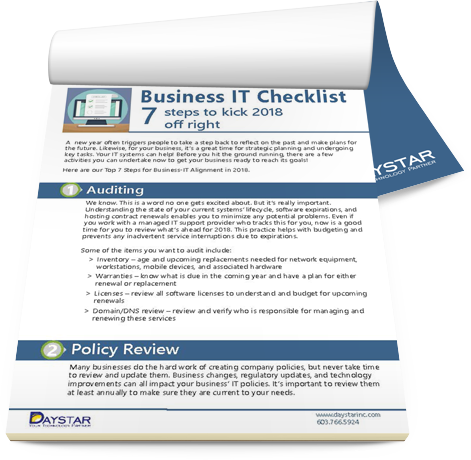Motivate your team for a successful technology deployment
You’ve done the research and pulled the trigger. You bought the new software platform, or selected a different email system, or purchased a new cloud storage solution. Now it’s time to deploy the technology to your business.
One of most important factors in whether a new technology deployment is successful or not is your people. Yet often, when deploying something new, people only consider the technical aspects… timelines, deliverables, budget, etc. In my experience managing hundreds of IT projects for our clients, I have found that employees’ attitudes and willingness to engage can make or break a project.
You need to consider the human factor. And humans are averse to change. Your team is used to specific tools and doing things a certain way. And they will likely meet change skeptically – even if it’s change for the better.
New technology often results in an organizational change that must be handled deliberately. Employees must be led through the adoption phase to fully embrace new systems and tools. It takes effort, time, and patience to create employee buy-in. It’s important to build this into your project plan.
5 Ways to Encourage Employee Adoption
1. Choose Carefully
Employee buy-in doesn’t begin at the end with a training program, it starts at the beginning with what you’ve chosen to implement and why.
You should know –
- What benefits does this new tool provide?
- How will it make employees’ lives better? And if it won’t, how will it make the company better?
- Are there other frustrations or challenges that your team considers to be a higher priority?
- Is your team familiar with this type of technology? Will they understand how it fits into their workflow?
Consider not only features and functionality, but ease of use. It’s tough enough to get buy-in just because something is new and different. It’s even harder if that it’s complex and difficult to navigate. If your new technology is intricate by nature, it’s important to build in the necessary training to support adoption.
2. Communicate... Again, and again, and again....
How you roll out a project and educate your team is just as important as what you roll out. There is the option of force-feeding new technology (use it or else), but this often produces negative outcomes, such as a watered-down deployment, dissatisfied employees, and loss of confidence in leadership. Avoid alienating your people by making it a direct order, even if it is.
Communicate the why
I often find that I need to “sell” a client’s project to their internal employees because they don’t understand why the company is implementing a change. Help them understand what the value is. Describe the reason for the new technology and how it benefits them. Your team is busy; if they don’t see the new tool as being important to their work, they are likely to be dismissive or ambivalent. If possible, highlight real-world examples of the new tool in action so they gain a real context of the value.
Be inclusive
Most small to midsized businesses should communicate to all employees. Although some people just focus on the main stakeholders (e.g. customer service reps for a new CRM tool), it is important to consider other groups that may be impacted (e.g. the sales team or service group.) Don’t assume. Document ahead of time how the new systems will impact all employee groups and communicate accordingly.
Think ahead
In any change process, fear of the unknown is a big hurdle. Communicate the plan. Make sure your team is aware of key dates, project phases, training opportunities, and expectations. Listen to their feedback and alter the plan if needed.
Likewise, prepare your team for the inevitable road bump or hiccup. Implementing new technology encompasses a lot of moving parts. Acknowledge the unexpected and let your team know how you will approach and overcome project challenges.
Be open
Your team should feel empowered to ask questions. It’s okay not to understand everything there is to know about a new technology. Cultivate an approachable environment where your employees feel comfortable talking about their concerns or questions. We find that the more open a client environment is, the more successful their rollout goes.
3. Engage early adopters
Your employees have varying technical skills, from beginner to expert. Identify those employees who might help lead the adoption efforts. If possible, allow them to try it out ahead of time and provide feedback. They may have new insights into the value it brings and how it fits into the team’s workflow. Or they might identify challenges you didn’t know existed.
Throughout the implementation process, early adopters can help support the rest of the team as they undergo training or work to familiarize themselves with the new system. And they are an additional set of eyes and ears to help identify any potential roadblocks or employee frustration.
4. Training
Successful deployments require more than just sending email or holding a one-time training session. Employee education and training should be built in to the project plan.
Be effective
Plan and budget for training. Small groups provide more opportunities for personal guidance and hands-on experience. Be sure to allow ample time for questions and plan for future follow-up and feedback.
If possible, have your team participate in the actual deployment, not just training. If they are present when their workstation is being set up, they can ask questions and review concerns in live time with project engineers. We can often predict that if an employee is absent on the day of a big deployment, they will be chasing down follow-up questions or concerns in the days to come.
Keep your eye on the prize
Keep your team focused on the big picture. Again, reinforce the why. By focusing on the outcomes and value the new technology will deliver, you are giving them a reason to use it and keeping them engaged.
Make if fun and engaging
Learning something new is hard – especially for busy people focused on their jobs. Do what you can to make the process as fun and simple. Depending on your office environment, use fun training formats like lunch and learns or game-style training. Show them that you value the effort they are making to learn something new by offering incentives. It doesn’t have to be too involved – small gift cards for coffee, tchotchkes, an additional company perk, or some sort of recognition will do.
For example, one of our clients provides employees with a catered lunch when they implement a new IT project. It’s a small way to provide a treat for the team on what can be a potentially stressful day.
4. Measure and Follow-up
Employee adoption can also fail after a project has been implemented and training is finished. Once a rollout is complete, we tend to sit back, relax, and take a proverbial pat on the back. Such complacency can result in reverting to “old ways” or just abandoning something new. Build in ongoing measurement and periodic follow-up to ensure success.
Set milestones and define what employees should be able to accomplish. Track it and evaluate whether your team has sufficient skills or requires additional training. Celebrate accomplishments and continually reinforce the value. Remember, it may not be obvious to everyone.
You invest a lot of time, money, and resources evaluating, selecting, and purchasing new technology. Protect that investment by setting yourself up for a successful rollout. Ensuring that your team is on board and encouraging employee adoption is critical to the success of the project and reaping the intended benefits.
Learn how smart IT solutions help you achieve greater business growth.
Call today at 603-766-5924 or contact us online!














